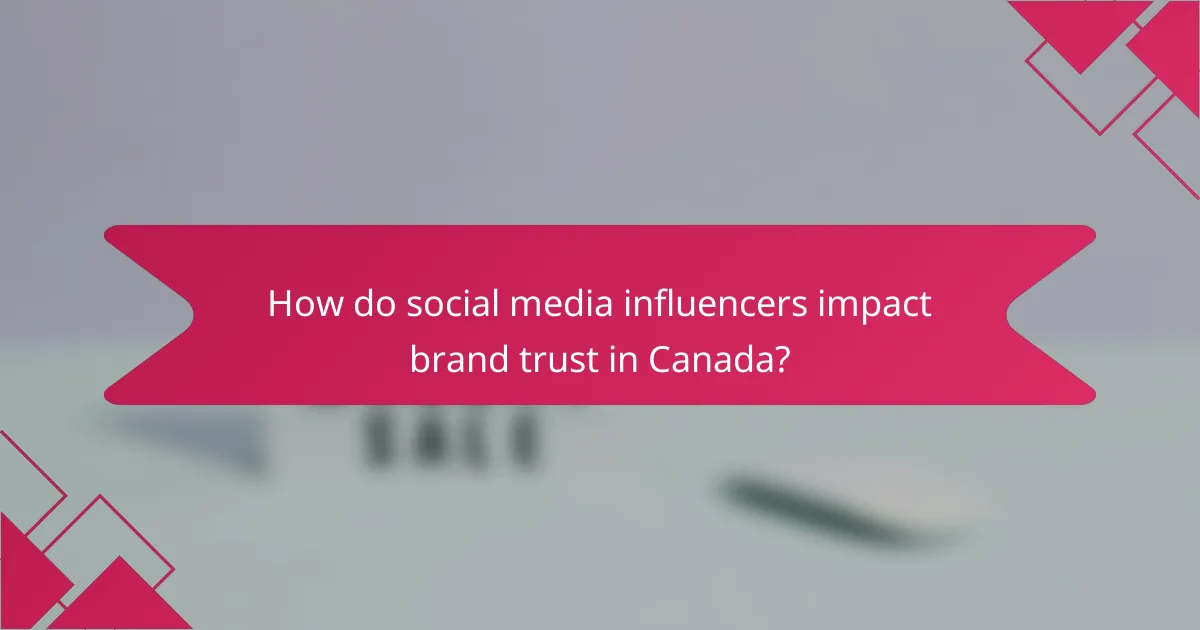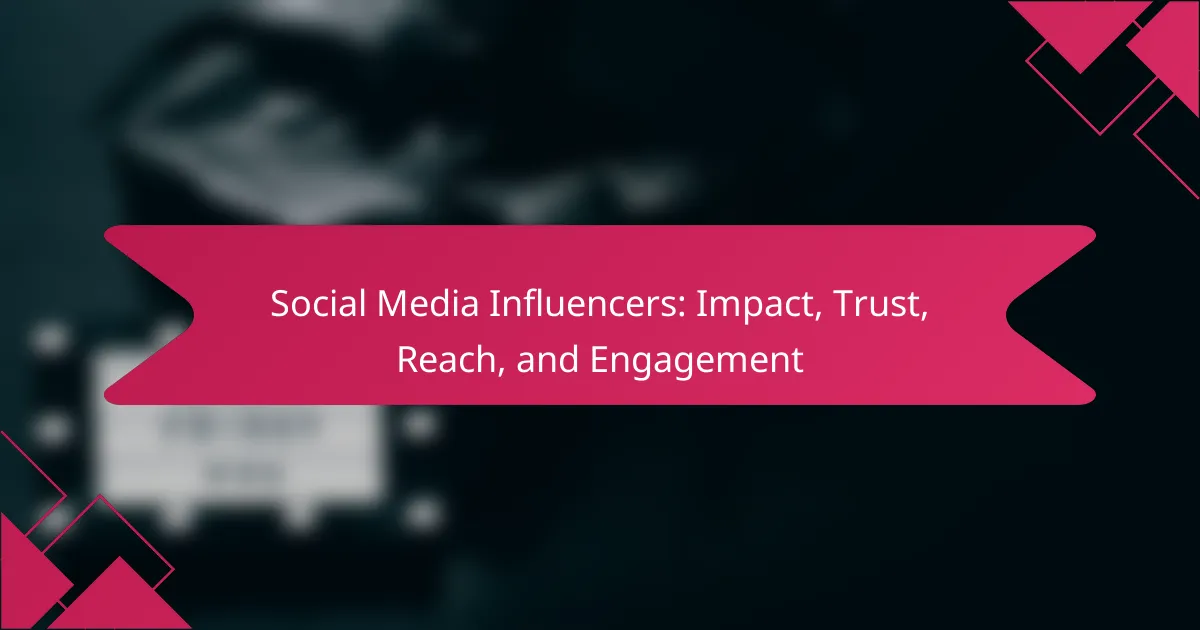Social media influencers play a crucial role in shaping brand trust and engagement in Canada by creating authentic connections with their audiences. With the ability to reach millions and connect with niche markets, they serve as powerful marketing tools for brands seeking to enhance visibility and foster reliability. By collaborating effectively with influencers, brands can not only increase their reach but also build lasting trust with their target audience.

How do social media influencers impact brand trust in Canada?
Social media influencers significantly enhance brand trust in Canada by fostering personal connections and providing authentic endorsements. Their ability to engage with audiences creates a sense of reliability that traditional advertising often lacks.
Increased authenticity through personal connections
Influencers build strong relationships with their followers, which translates into a perception of authenticity. When influencers share personal stories or experiences related to a brand, it resonates more deeply with their audience, making the brand feel more relatable.
This connection encourages followers to trust the influencer’s recommendations, as they perceive them as genuine rather than purely commercial. For brands, collaborating with influencers who align with their values can enhance their image and foster loyalty among consumers.
Influencer endorsements enhance credibility
Endorsements from trusted influencers can significantly boost a brand’s credibility. When an influencer promotes a product, their established authority in a specific niche lends weight to the brand’s claims, making consumers more likely to consider purchasing.
For example, a beauty influencer endorsing a skincare product can lead to increased sales, as their followers often seek advice from someone they trust. Brands should choose influencers whose audience aligns with their target market to maximize the impact of these endorsements.

What is the reach of social media influencers in Canada?
Social media influencers in Canada have a significant reach, often engaging millions of followers across various platforms. Their ability to connect with niche audiences makes them powerful marketing tools for brands looking to enhance visibility and engagement.
Access to diverse audience demographics
Influencers in Canada can tap into a wide range of audience demographics, including age, gender, and interests. This diversity allows brands to target specific groups effectively, whether they are millennials interested in fashion or older adults seeking lifestyle content.
For example, a beauty influencer may attract a predominantly female audience aged 18-34, while a tech influencer might engage a more mixed demographic that includes younger tech enthusiasts and older professionals. Understanding these demographics helps brands tailor their messaging and product offerings.
High engagement rates compared to traditional media
Social media influencers typically achieve higher engagement rates than traditional media outlets. Influencers often see engagement rates in the low single digits to high double digits, while traditional media may struggle to reach even a few percent.
This higher engagement is largely due to the personal connection influencers establish with their followers. For instance, an influencer’s authentic recommendation can lead to increased trust and interaction, making followers more likely to comment, share, or purchase products endorsed by the influencer.

How can brands effectively collaborate with influencers?
Brands can effectively collaborate with influencers by establishing clear goals, selecting the right influencers, and fostering genuine relationships. This approach not only enhances brand visibility but also builds trust with the target audience.
Identifying the right influencers for target audience
To identify the right influencers, brands should analyze their target audience’s demographics, interests, and online behavior. Tools like social media analytics can help pinpoint influencers whose followers align with the brand’s customer profile.
Consider factors such as engagement rates, content style, and authenticity. Influencers with a smaller but highly engaged following can often yield better results than those with a large but passive audience.
Creating authentic partnerships for better results
Creating authentic partnerships involves open communication and collaboration with influencers. Brands should allow influencers to maintain their unique voice while promoting products, as this fosters genuine endorsements that resonate with their audience.
Establish clear expectations regarding deliverables, timelines, and compensation. Offering fair compensation, whether monetary or in-kind, can strengthen the partnership and encourage more enthusiastic promotion of the brand.

What metrics measure influencer engagement?
Influencer engagement is primarily measured through metrics such as engagement rate, follower growth, and interaction quality. These metrics help brands assess how effectively an influencer connects with their audience and the potential impact on marketing campaigns.
Engagement rate calculations
The engagement rate is a key metric that reflects the level of interaction an influencer’s content receives relative to their follower count. It is typically calculated by dividing the total number of interactions (likes, comments, shares) by the total number of followers, then multiplying by 100 to get a percentage. A good engagement rate generally ranges from 1% to 5%, depending on the platform and niche.
When evaluating engagement rates, consider the type of content and the audience’s demographics. For example, micro-influencers often have higher engagement rates than larger influencers due to their more targeted and loyal follower base. Brands should compare engagement rates across similar influencers to identify the most effective partners.
Follower growth tracking
Follower growth tracking involves monitoring the increase or decrease in an influencer’s follower count over time. This metric provides insights into the influencer’s popularity and the effectiveness of their content strategy. A consistent growth rate is typically seen as a positive indicator, while sudden spikes or drops may require further investigation.
To effectively track follower growth, brands can use social media analytics tools that provide historical data and trends. It’s essential to consider the context behind follower changes, such as seasonal trends, content campaigns, or external events that may influence audience behavior. Regularly assessing follower growth helps brands make informed decisions about their influencer partnerships.

What are the challenges brands face with influencer marketing?
Brands encounter several challenges in influencer marketing, including maintaining authenticity, managing reputational risks, and measuring campaign effectiveness. These hurdles can impact the overall success of influencer partnerships and require careful consideration and strategy.
Maintaining authenticity in partnerships
Authenticity is crucial for successful influencer marketing. Brands must ensure that the influencers they collaborate with genuinely align with their values and resonate with their target audience. This alignment fosters trust and encourages followers to engage with the brand’s message.
To maintain authenticity, brands should conduct thorough research on potential influencers, examining their content, audience demographics, and engagement rates. Establishing clear communication about expectations and allowing influencers creative freedom can also enhance the authenticity of the partnership.
Managing influencer reputation risks
Influencer reputation risks can significantly affect a brand’s image. If an influencer faces controversy or negative publicity, it can lead to backlash against the brand they represent. Brands must be proactive in monitoring their influencers’ activities and public perception.
To mitigate these risks, brands should implement a vetting process that evaluates an influencer’s past behavior and current reputation. Regularly reviewing the influencer’s content and engaging in open dialogue can help identify potential issues before they escalate. Additionally, having a crisis management plan in place can prepare brands to respond swiftly if a situation arises.

How do Canadian regulations affect influencer marketing?
Canadian regulations significantly shape influencer marketing by enforcing guidelines that ensure transparency and honesty in advertising. Influencers must adhere to specific rules regarding disclosure and compliance to maintain trust with their audience and avoid penalties.
Disclosure requirements for sponsored content
In Canada, influencers are required to clearly disclose any sponsored content to their audience. This means that if a post is paid for or if products are provided for free, the influencer must indicate this relationship, typically using hashtags like #ad or #sponsored.
Failure to disclose can lead to penalties from regulatory bodies such as the Competition Bureau. Influencers should aim to make disclosures prominent and understandable, ensuring that their audience is aware of the commercial nature of the content.
Compliance with advertising standards
Influencer marketing in Canada must comply with the Canadian Code of Advertising Standards, which emphasizes truthfulness and accuracy in advertising. Influencers must avoid misleading claims and ensure that any endorsements reflect their genuine opinions and experiences with the products.
To stay compliant, influencers should regularly review the guidelines set by the Advertising Standards Canada (ASC) and consider consulting legal advice when in doubt. Maintaining transparency not only fulfills legal obligations but also fosters trust with followers, enhancing long-term engagement.

What emerging trends are shaping influencer marketing?
Emerging trends in influencer marketing are significantly transforming how brands connect with audiences. Key developments include the rise of micro and nano influencers, increased focus on authenticity, and the integration of new technologies like AI and augmented reality.
Rise of Micro and Nano Influencers
Micro and nano influencers, typically defined as those with fewer than 100,000 and 10,000 followers respectively, are gaining traction due to their perceived authenticity and higher engagement rates. Brands are increasingly partnering with these influencers to tap into niche markets and foster genuine connections with their audiences.
For example, a local skincare brand might collaborate with a beauty blogger who has a dedicated following in their community, resulting in more targeted marketing and better ROI. This trend emphasizes the importance of quality over quantity in influencer partnerships.
Focus on Authenticity
Authenticity is becoming a critical factor in influencer marketing, as consumers are increasingly skeptical of overly polished content. Brands are now seeking influencers who present a more relatable and genuine image, which can lead to stronger trust and loyalty among followers.
To enhance authenticity, brands should encourage influencers to share personal stories or experiences related to their products. This approach resonates more with audiences, fostering a sense of community and connection.
Integration of New Technologies
The integration of technologies such as artificial intelligence and augmented reality is reshaping influencer marketing strategies. AI can help brands analyze influencer performance and audience engagement, while augmented reality offers interactive experiences that can enhance product promotion.
For instance, a fashion brand might use AR to allow users to virtually try on clothes through an influencer’s social media post. This innovative approach not only engages consumers but also provides a unique shopping experience that can drive sales.










